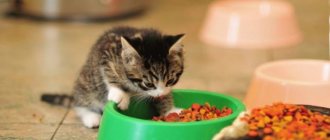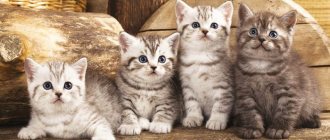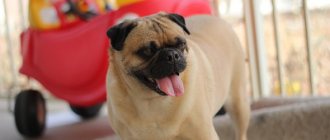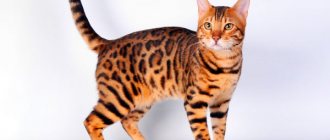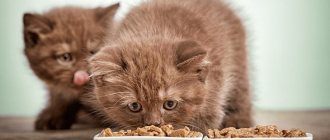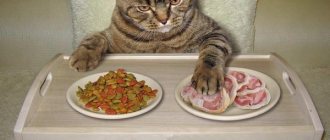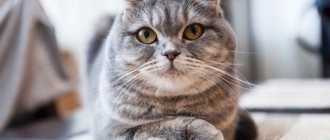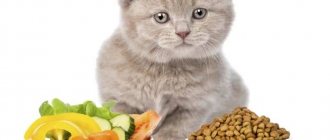Kitten feeding regimen
To begin with, it is important to understand when to introduce complementary foods and how often to feed the kitten. You, of course, can be guided by the kitten's hungry look, but it is better not to awaken the beast in him, and 3-4 weeks after birth, begin to gradually feed the baby.
By 4 weeks of age, a stable eating schedule should be established.
The baby should receive additional feeding 4-7 times a day.
But there are stalemate situations when kittens need additional feeding much more often.
How many times a day should you feed your kitten?
- age up to 2 weeks – 10 times a day (with night coverage);
- feeding a one-month-old kitten – 8 times a day (including the night);
- 1 - 2 months - 7 times a day (night is already excluded);
- 2 - 3 months - 6 times a day;
- 4 months - 5 months - 5 times a day;
- 5 - 9 months - 4 times a day;
- 9 - 12 months - 3 times a day;
- Feeding kittens from 1 year of age becomes twice a day (for example, 9:00 – 21:00).
How much food to give a kitten:
- Age 1 week – 30 ml per 100 g of kitten weight;
- 2 weeks – 38 ml per 100 g of kitten’s weight;
- 3 weeks – 48 ml per 100 g of kitten’s weight;
- 4 weeks and subsequent – 48-53 ml per 100 grams of kitten weight.
How much should a kitten receive per day?
Of course, it’s easy to calculate the amount of feed based on the items already proposed, but we’ll make the task easier and give a few numbers:
- At 1.5 months, a baby needs about 120 grams of food per day;
- We feed a two-month-old kitten more - 160-180 grams per day;
- During the period of active growth (3 months - 6 months), the daily food intake is 180-240 grams, with at least 40 grams of meat;
- A six-month-old baby needs up to 180 grams of food per day;
- At 10-12 months, the period when the kitten’s activity decreases, the daily food intake is 150-200 grams.
It is important to give vitamins to your pet.
Feeding kittens from 0 to 6 months Childbirth, although natural, is an absolutely unpredictable process. Complications associated with labor often lead the mother to the operating table or force her to undergo drug treatment. It doesn’t matter for what reasons kittens are left without mother’s milk, it is important to know what to do next and how to properly feed the kitten with a pipette.
If the birth is planned, buy a bag of cat milk replacer; if you don’t need it for kittens, give it to mom, she won’t mind the extra vitamins and protein. During the “season” for the birth of stray kittens, abandoned newborn babies are often found. When you find a find, act quickly - ask, buy, but find food for the kittens!
Cat's milk consists of 50% protein, and its complete analogues do not exist. Suitable for feeding are cat milk substitutes (sold in pet stores), infant formula without additives and sugar, natural condensed milk without sugar (prepared at home), products for newborns from the “dairy kitchen”, goat milk, in extreme cases - homemade cow milk.
You will need a pipette, an insulin syringe with a soft plunger, or a special nipple for feeding. A well-washed and boiled tube of naphthysin or other drops and a rubber band from a pipette as a pacifier will be suitable for available means. Make sure that the elastic band is held very tightly and is made of medical latex!
If a kitten has swallowed a piece of latex, drop 1-2 drops of Vaseline oil into the animal’s mouth every 2 hours. Fat envelops the disintegrating latex and removes it from the body.
If you decide to syringe feed your kittens, practice; the milk should be squeezed out drop by drop. A kitten’s protective reflexes are weaker than those of adult animals; a choked baby is almost impossible to resuscitate.
It is advisable to feed the kittens in a natural position - the animal lies on its stomach, rests its hind legs on the floor, and tramples the side with its front legs. One option is a cat litter box with a low side, covered with several layers of fabric or a thick towel.
For the first 3 days, kittens eat every 2 hours, day and night. After surviving 3 days, switch the kittens to food once every 4 hours.
The milk must be warm! 30–39 C° in the first 3 days, not lower than 30 C° in subsequent days.
Feed the kitten until he stops sucking; most often, after eating, kittens immediately fall asleep. At your discretion, before or after feeding, gently massage the tummy and area under the tail with a damp, warm cloth or cotton swab until the baby defecates. This stage is extremely important; kittens cannot empty their intestines and bladder without stimulation - licking or its imitation. After defecation, the kitten needs to be fed.
Kittens should be in a warm nest (temperature no lower than 25 C°) with dim lighting until their eyes are fully open; kittens do not tolerate bright light.
For full development, kittens need to crawl and be in contact with their mother. Place a heating pad wrapped in wool in the nest, using a stuffed toy as a “reservoir” for the heating pad.
How many times a day should you feed a kitten?
When feeding, you will have to focus on the individual characteristics of the pet. Then how many times a day should you feed a kitten?
Number of meals and daily weight
Many owners get confused when they don't know how often they should feed their kitten. How often food should be given will directly depend on the age of the pet.
3 – 4 weeks: these fluffies need to be fed 7 – 8 times a day, even at night. The total weight of food per day should be about 120 - 130 grams.
1.5 - 2 months: at this age, kittens need a little less, so you can safely remove one feeding at night, and give the kitten food 6 - 7 times a day: the amount of food can be increased, giving 150 - 180 grams per day.
2 – 3 months: at this stage you can already continue 6 doses per day. The portion increases to 230 grams per day and this weight can be maintained for up to 6 months.
4 – 6 months: you should not feed often, reduce it to 5 times a day.
6 – 9 months: the portion is noticeably reduced, now you can feed 3 – 4 times a day. The serving weight is also reduced and 180 grams per day will be enough.
1 year: When the kitten's age begins to approach 1 year, you can switch to three meals a day. At this figure, you can switch to stability and the weight of the portion for each day should be 180 - 200 grams.
Your kitten's meals should be balanced
Calorie content
You can avoid various incidents in your kitten’s nutrition if you calculate the required calorie intake for the day and give the kitten food strictly within this norm.
For 1 kg. weight requires 40 - 60 kcal. in a day. Calorie content can be calculated thanks to special stickers on packs of food located on the back side of the packaging. You just need to measure the kitten's weight and calculate the calorie content accordingly. Also, for 1 kg. weight, you need to provide 10 grams of protein, 2 grams of fat, 1 gram of carbohydrates and 1 gram of fiber.
Water mode
The cat family is a light-drinking animal. You can often notice that the bowl is always full of water. Water is the most important source of life for a growing organism. It has been established that small kittens have high water needs: about 60 – 80 ml per day, or even more. Babies up to 3 weeks feed exclusively on milk, which supports their functions in the body, after which they can switch to water, which they also need. Approximately 1 kg. weight required 80 ml. liquids.
Kittens are very active at their age, so they lose a lot of water, in addition to the process of breathing, thermoregulation and urine excretion. That is why the water balance should always be restored with water in the bowl.
A kitten's hydration plays a huge role in its health.
Food basket for kittens
Let's look at the cat's “food basket” - what you can feed kittens from homemade food, that is, “natural food”. The first thing is meat, namely beef. A bird would also work. It is better to avoid pork; a kitten can easily overeat it out of habit; on top of everything else, it is a source of helminthiasis infection. If we talk about fish, there is nothing better than sea fish. You can get a lot of things from river fish. But even sea fish should be given infrequently - a couple of times a week is more than enough. For young creatures, the meat must be boiled, but older pets can eat it raw, but only in moderation.
What better way to feed a kitten than with milk; there is simply no dearer food for it. However, not every cat will drink cow's milk. In some animals, the stomach simply cannot tolerate it. In such cases, the baby can be given yogurt or other fermented milk product. The main thing is that its fat content is not too high. Another good product for a growing animal is cottage cheese. Small pets are given cottage cheese puree with yolk, milk, or all together. Few people will refuse such “mogol-mogol” and usually the kitten devolves it with great pleasure. You can also pamper your pet with rennet cheese and sour cream.
In order for an animal to develop fully, it requires fiber contained in products of plant origin - these are vegetables and cereals. To compensate for this need, the kitten needs to cook porridge. For the smallest kittens, on a milk basis, and for older animals on meat, chicken, and fish broths. Only legumes should be avoided, since it has already been mentioned that feeding legumes leads to bloating and constipation, and they are also poorly absorbed by the body. Meat and vegetables are added to porridges made with meat broths.
Don't forget that your baby should have 24/7 access to fresh water. This aspect is especially important when feeding dry food. After all, cats that consume store-bought food drink almost four times more water than animals that eat natural products. Change the water regularly, and wash the container underneath and scald it with hot water.
How to feed a kitten
At this age, the kitten should eat the same type. This means that you need to stick to feeding either natural food or ready-made food. When moving to a new home, the baby should be kept on his usual diet. When a new owner decides to transfer his four-legged friend to a different type of food, he should start doing this gradually, after a month. This is due to the fact that the kitten needs some time to adapt to new conditions. Next, we’ll look at what to feed a 3-month-old kitten.
Which food is better for kittens - dry or wet?
The opinions of different experts regarding the issue of artificial food do not agree: there are many pros and cons of such a diet. Each owner makes his own decision regarding the diet of his beloved pet and, if you prefer special canned food or dry pads, you must choose what food to feed the kitten. There is no significant difference between the two types of cat food, however, there are more cases of animal poisoning among those who eat canned food.
When choosing, you should take into account the age and breed of the animal. Many food manufacturers provide the addition of various substances for hair growth, which is important for British and Scottish folds, but completely useless for sphinxes. Feeding a kitten canned food for adult cats is fraught with indigestion and other side effects, so it is important to pay attention to the recommended age indicated on the package.
Advantages
Each feeding option usually has its pros and cons. It’s probably worth starting with the main advantages of this type of nutrition:
- The opportunity for the owner to select products for preparing food for kittens, focusing on their freshness and quality. This allows you to have more confidence that the prepared food is healthy for the baby.
- The food that is intended for the animal is always fresh, there are no chemicals in it, and therefore it will not only be useful for the still weak body, but also safe.
- The pet receives a variety of food daily.
- This food does not contribute to the development of addiction, the kitten will not suffer from painful addiction. Some foods can be freely replaced with others without causing stress to the kitten.
Flaws
As for the negative aspects of natural feeding of an animal, the following main points should be highlighted:
- It is necessary to carefully monitor that the diet does not contain foods that are undesirable, or even dangerous, for the kitten’s digestive system.
- Ordinary food does not always contain enough vitamins necessary for the normal development of a kitten at two months of age. To balance the diet, you will have to buy them specially and, after calculating the dose yourself, add them to your cat’s dishes.
But regardless of the option you choose to feed your pet, protein should be the basis of nutrition. Only they participate in the construction of a living organism. Therefore, the diet should consist of foods that are rich in protein, in a proportion of approximately more than half of the daily diet. Fish and meat products have a sufficient amount of protein.
But not only protein foods should be included in the baby’s diet. It is necessary to ensure that it contains various vitamins and microelements in sufficient quantities. The kitten's body is growing and it needs to have plenty of calcium, which promotes tooth growth and skeletal development. These substances are found in whole milk and fermented milk products. Knowing what a kitten should eat for 2 months and what should be removed from its diet, the baby’s owner will be able to confidently create a high-quality diet that will include necessary and healthy natural products.
HOW OFTEN AND HOW MUCH SHOULD I FEED A KITTEN?
It is important to feed your tiny newbie small meals at regular intervals, up to 6 times a day. Some veterinarians prefer free feeding, which means providing kittens with unlimited food throughout the day, gradually progressing to feeding at four to six months of age. From the very beginning of a kitten's growth, preventing obesity is much easier than fighting it when it becomes a problem.
Determining how much to feed a kitten is not easy. Even when you reach the desired amount, it will change before you notice it. Kittens just grow up so fast. How much to feed a 3 month old kitten is different from how much to feed a 4 month old kitten, not to mention how much to feed a 6 month old kitten!
You have to constantly re-evaluate how much food you give your kitten, but the effort is worth it. Feeding your kitten the right amount of food is one of the best ways to help it grow into a healthy, happy adult cat.
How much to feed a kitten at each stage of its growth
Age and size are the main factors that influence how much to feed your kitten. Feeding Newborn Kittens Up to 4 Weeks Newborn kittens nurse frequently, approximately every two hours during the first week of life, and then gradually reduce to four to six times a day. Checking their weight daily is the best way to ensure they are getting everything they need. Kittens should gain approximately 15-20 grams each day. If young kittens cannot receive adequate nutrition from their mother, they must be supplemented with formula.
Feeding kittens aged 4 to 6 weeks
At about 3-4 weeks of age, kittens can begin to be weaned and switched to kitten food see website Several times a day, give them soft food such as Perfect Fit Junior wet food for kittens or Whiskas also wet food for kittens other types of wet food . By 5-6 weeks, cereal is no longer needed because the kittens' baby teeth have sprouted and they can chew their food better.
Feeding kittens aged 6 to 8 weeks
By 8 weeks of age, kittens should be able to drink water and feed themselves. At this point, you can start offering dry food, but soak it in a few tablespoons of warm water to make the transition easier. Most 8-week-old kittens weigh around 2.5-3 kg, which means they should consume an average of about 162 kilocalories per day.
Feeding kittens aged 8 weeks to 10 months
The fastest growth period occurs in the first six months of a cat's life, after which their need for "extra" calories and nutrients begins to decline. For example, if your cat's body is too thin, your veterinarian may recommend that your kitten consume more calories than is recommended for a kitten with an ideal body shape.
Feeding kittens over 10 months
Most kittens can be switched to adult cat food at around 10 months of age. Kitten food typically contains more calories, fat, and protein than cat food.
Some cats, such as those that are naturally very petite or prone to gaining weight, benefit from making the switch earlier. Others (such as large breeds such as Maine Coons) may need to stay on kitten food longer. Your veterinarian can help you determine when to switch from kitten food to adult cat food.
Consequences of poor nutrition
Poor nutrition, especially during the growth period, is the cause of many diseases and disorders:
- Stunted growth;
- Incorrect formation of the skeleton;
- Metabolic disorders;
- Reduced immunity;
- Allergic reactions;
- Poisoning;
- Worm infestations;
- Reproductive dysfunction.
Without following the basic rules and norms of feeding, it is impossible to raise a healthy animal that meets all the characteristics of the breed.
Natural nutrition
Those who adhere to the position of feeding kittens with natural food are confident that only such food is safe and healthy for them. Naturally, for them there is no question of what to feed the baby at this age, since they have already made their choice. However, it is worth noting that natural foods that are considered acceptable for kittens are not at all the same products that humans consume. This is a specially produced food that contains useful substances and no chemical additives.
Feeding regimen for a 4 month old kitten
During the day, a kitten of this age should eat about 200 grams. food per 1 kg of live weight (for medium-weight kittens, 400 grams of food per day is enough; in one meal, he should eat approximately 100 grams of food). For a baby aged 3 months, 180 grams is enough. food, and for a four-month old 200 grams. (with an active lifestyle) may not be enough, especially if the kitten is large. Appetite and need for nutrients depends on the exact age, weight of the pet, its breed, activity, and health. Experts recommend creating a different diet for each day of the week. Babies up to the age of 4 months need to be given food 5-6 times, and a kitten older than 4 months can be fed 4 times a day.
Ready-made food for kittens
Today, there are a lot of ready-made food for kittens. Whether to give such food to a pet is a personal matter for the owner.
If you decide to introduce ready-made food into your kitten’s diet, you should remember the following rules:
- Under no circumstances should you give your pet food from different manufacturers. You should choose one, the most optimal food for regular feeding of the kitten.
- You cannot feed your pet the cheapest food.
- From time to time, in addition to food, the kitten needs to be given natural food.
- A kitten that eats food must drink a lot. The water must be filtered and located in such a place that the pet can reach it at any time.
- When choosing food for a kitten, you must be sure to familiarize yourself with its composition. If the composition is questionable, choose another food.
A kitten's nutrition is the key to the animal's health. Don’t forget that your pet’s immunity is formed at an early age. Therefore, the kitten’s diet should include fresh and vitamin-rich foods.
Proper feeding of a suckling kitten
Now about how to feed a newborn kitten from a technical point of view. If the kitten sucks the formula from the bottle incorrectly, it does not eat enough, swallows air, etc. This leads to additional sleepless nights and anxiety.
Something else interesting :
- Protein sources for cats – eggs
- It is best to hold the kitten on your lap or with a warm towel in your palm. How to hold the bottle will be described in detail in the instructions for the mixture. But in general, the kitten should be positioned at an angle of 45 degrees to the horizontal and tightly grasp the nipple. Avoid breaking the latex nipple and avoiding excessive tilting of the bottle. The entire nipple should be filled with liquid to prevent the kitten from swallowing.
- You will have to bottle feed your baby for at least 2 weeks from birth; you cannot add anything during this time. If you have any problems, contact your doctor immediately and do not self-medicate. Such small kittens are not dewormed until they are stronger. It is also forbidden to poison a kitten with fleas. The maximum that can be done for a healthy newborn kitten is to drive fleas off the litter.
Optimal feeding regimen for a kitten
When deciding how many times to feed your kitten dry food, first of all take into account your own work schedule. Typically, the daily food intake, calculated in accordance with the manufacturer's recommendations, is divided into three equal parts and given in the morning, lunch and evening. If you can't feed your pet in the middle of the day, don't worry: he won't go hungry even if you fill the bowl twice a day. Such feeding looks like twice a day only from the owner’s point of view, but the kitten manages to eat up to 10–15 times a day.
The fact is that the eating habits of cats are fundamentally different from human ones; they eat food often, but in small amounts. If the kitten went to the bowl, ate a few granules and went about its business again, this does not mean that it does not like the food. In an hour or two he will return for a new portion of “fuel”, which is absolutely normal for his age and biological species. Just leave dry food freely available and make sure there is always clean, fresh water in the second bowl.
If the kitten does not finish the daily portion, then you should not pour the next portion on top: it is wiser to reduce it by the amount of what was not eaten. Remember that the standards on dry food packaging are only a guideline and do not take into account the individual characteristics of the animal. If the kitten gets enough food but still grows well, there is no reason to worry. In some situations, on the contrary, a little more food may be required. For example, when an animal is clearly underweight.
Solid food feeding
As soon as the kitten has its first sharp teeth, you can gradually give it other foods other than milk. There are no unusual products in this complementary food. It is very important that the animal's food is warm. You can feed him well-cooked oatmeal with the addition of hard-boiled egg yolk. Cottage cheese diluted with warm milk, it is advisable to grind it with a teaspoon until it becomes mushy. Ground beef, pour boiling water over it, or freeze it in the refrigerator for 2 days to kill some harmful bacteria.
Keeping a routine
At the age of 2-3 months, the kitten, as a rule, already switches from mother's milk to ready-made diets. At this time, the animal requires rich and regular feeding. He should be given food in small portions 5 times a day.
It is important to remember that in the first three months of life, the kitten’s digestive system finishes forming, and the skeleton becomes stronger. To provide it with all the nutrients in the proper proportions, it is recommended to combine wet and dry diets. You should divide a bag of wet food into four servings that your kitten can eat throughout the day, and leave 23-28 g of dry food for snacks.
After three months, the kitten is transferred to three feedings a day. He should be given a whole bag of wet food for breakfast, and another half a bag for lunch and dinner. It is also recommended to leave 33 g of dry food for daytime snacks. In this mode, the kitten should be fed for up to a year, increasing only the amount of dry food by 1 g per month.
Further complementary feeding
So, time flies very quickly, and in a couple of months the kitten turned from a little fool into a charming playful creature. Now he needs more and more strength and energy, so his nutrition should be different, and a new product should be introduced weekly. They try to give boiled lean chicken, rabbit or turkey; low-fat sour cream, boiled beef liver, boiled fish or poached for a minute, separated from the bones. Boiled and chopped chicken or quail egg. Pumpkin puree with milk.
Any unfamiliar food should be given to a kitten in small doses and its behavior and well-being should be carefully observed. If the influence of a new bait negatively affects him, it is best to exclude him from the diet.
Age 3-6 months
At this point, the kitten's teeth and jaws are fully formed. Therefore, you can forget about the grater. But you'll have to pick up a knife. Because pieces that are too large will only be slobbered on and thoroughly chewed, but they will never get into the kitten’s stomach.
But now you don’t have to necessarily cook the meat and vegetable components of the menu. Of course, you will still have to cook the porridge, because kittens do not eat raw cereals. Raw fish is added to the diet. Strictly sea and boneless. River fish is contraindicated!
The milk is completely removed. It is replaced with low-fat cottage cheese or fermented milk products. You can sometimes give egg whites, raw ones. But teenage kittens often become indifferent to eggs in general. But at this time, unexpected taste habits are formed. Therefore, it is very important now to diversify your pet’s menu as much as possible. Otherwise, he will get used to one product and simply ignore the rest.
By the way, there are many known cases when kittens after 3 months demanded completely non-cat products:
- corn
- honey
- chocolate
- raw potatoes
- sunflower seeds
- fresh cucumbers
- dried fruits
Every normal person understands that such nutrition does not contribute to the full development and good growth of a kitten. Some make excuses by feeding the fluffy another candy: “Well, he loves it! »
You never know who loves it! But cats also have diabetes, obesity, urolithiasis and other human diseases. And they do not arise on their own. Domestic cats are fed by humans, which means that it is he who is to blame for the pet’s illness.
Do you want to pamper your kitten? Give him a prohibited non-cat product. But very little and very rarely. Let it remain a delicacy or a reward, but not a permanent menu item.
Controlling overeating
If a kitten meows and looks pitifully at its owner, this does not mean at all that it is hungry. Perhaps the pet just requires affection. You cannot replace it with food!
It is important to monitor signs indicating that the animal is full:
- rounded but not too bloated belly;
- washing;
- contented rumbling.
However, the kitten may demonstrate that there is not enough food for it. Then it is characterized by:
- restless behavior;
- attempts to grab the owners' hands;
- biting or sucking fingers;
- continued squeaks or meows.
You should not indulge the kitten and feed it. It is better to give him less food so as not to cause digestive problems.
With the right diet, the kitten will grow up healthy, beautiful and will not suffer from obesity and other diseases that can be caused by overfeeding.
What should you not feed your kitten?
Everyone knows that chips and cola are harmful to a child's health. He should not be given these products, as they have a detrimental effect on the body. The same goes for baby cats; their bodies also cannot process some foods. To keep your kitten healthy and active, exclude the following foods from its diet:
- The liver is useful only for humans, but for cats it does not have much benefit. If you give it to a kitten, then in vain - it is an empty product for him.
- Even if you feed your baby dry food (moistened in water), it is still necessary to add variety. For example, you can give meat and dairy products.
- River fish, even boiled ones, are carriers of all kinds of parasites. It should not be given to a kitten.
- Sausage, smoked meat, lard, fish and other similar products are food only for people. It contains a lot of fat, salt, seasonings and other components harmful to the body. By the way, this applies not only to cat health.
- Sweets are for children, not kittens. They ruin teeth, and in general, sugar is harmful to animals.
- Dog food! Never give one, even if the cat's supply is over. Go to the store and buy it. As a last resort, give natural food.
- Bread and other flour products.
Recipe for an inexpensive and tasty dish for a kitten
If the owner has a limited budget and time, then he needs to prepare food for the kitten in advance, which he can eat for several days in a row.
To do this, you need to finely rub 1 kg of beef through a sieve and add two chopped carrots to it. This mass must be supplemented with 200 grams of the simplest cheese, 2 yolks and a tablespoon of brewer's yeast. If desired, you can add a few drops of vitamins for animals.
This mixture should be carefully moved, rolled out with a rolling pin and placed in the freezer. Next, you need to boil the homemade food in small pieces
and feed the kitten. This product is used as the main food as it contains everything that is necessary for the full development of a young kitten.
When choosing any food, you need to pay attention to the condition of the animal.
. The kitten should always be in a good mood. It is imperative that he has smooth fur and strong claws.
You also need to observe whether your pet eats with appetite.
. After some time, the owner will independently understand what to feed the kitten. If your kitten is older than 3 months, you can switch to a balanced raw diet.
Recommendations from nutritionists:
- Don't feed your cat natural foods. When systematically combined, ready-made cat food and natural products will cause imbalance in nutrition - oversaturation of the body with some elements with a lack of others and, as a result, illness.
- Provide your cat with clean, fresh drinking water at all times. It is completely unacceptable to have a full bowl of dry food and an empty water bowl: the cat is at risk of dehydration.
- Canned cat food is more flavorful than dry cat food and comes in a wider variety of flavors.
- Heating canned cat food to a temperature of 39 – 40 °C can enhance its smell and indirectly improve its taste; this can be used when feeding a picky cat.
- Experts recommend not mixing dry and canned food - the effect of such a mixture is closer to dry food. It is better to feed your cat only canned food from time to time.
- Cats are very good at recognizing shapes and prefer food with small granules.
- It is not at all necessary to change food throughout the cat's life. You can choose a high-quality cat food from one brand and stick to it according to your cat's age and weight.
- Many diseases cause changes in taste in cats. In this case, you should use special dietary food for cats with the best taste (Hill's, Iams, Mars, Royal Canin).
And finally, you can determine how suitable the food you have chosen is for your cat using the following external indicators:
- Optimal fatness of the pet (ribs are not visible, but are easily palpated);
- Good physical condition;
- Shiny coat;
- Small volume of stool (approximately 25% of food eaten);
- Maintaining a constant weight of the cat.
Video
Features of feeding kittens by month
Feeding orphan kittens poses particular difficulties. Cow's milk is not suitable for a baby due to the suboptimal ratio of proteins, carbohydrates and fats.
For your pet to survive, you will need a cat milk substitute, for example, Babycat milk. From the end of the first month of life, the kitten is accustomed to dry granules for kittens. By the age of two months, the pet is able to feed itself.
Be sure to read:
What is better to feed cats, advice from veterinarians: dry or wet food
From birth to one month
Cat's milk replacer is dissolved in water heated to 38-40 °C. In the first week of life, a newborn is fed from a pipette, bottle, or syringe without a needle every 2-3 hours.
In the second week, the intervals are reduced to 4-6 hours. From three weeks of age, the milk mixture is poured into a saucer, gradually mixing in dry food.
From a month to two
Continue to use a milk replacer for up to 6-7 weeks, gradually increasing the amount of dry food. By the age of two months, the kitten eats dry granules and wet canned food.
From three to six months
A three-month-old kitten accustomed to dry food or a combination of granules and spiders does not cause any inconvenience for the owner. The number of feedings is gradually reduced to three. From the age of four months, the kitten can be switched to professional food for juniors.
A kitten that eats natural food changes owners by the age of 3 months. You need to ask the breeders what they fed the mother and kittens and try not to change the diet for the first 2 weeks.
It is necessary to switch to a new feed mixture gradually, over a week or more, so that the digestive enzymes can be rebuilt. The number of feedings is reduced from 5-6 to 3-4. Gradually teach the pet to eat offal.
From 6 months to a year
The pet is fed 2-3 times a day. Use professional food for juniors or natural food. The diet includes canned food in jars or offal.
